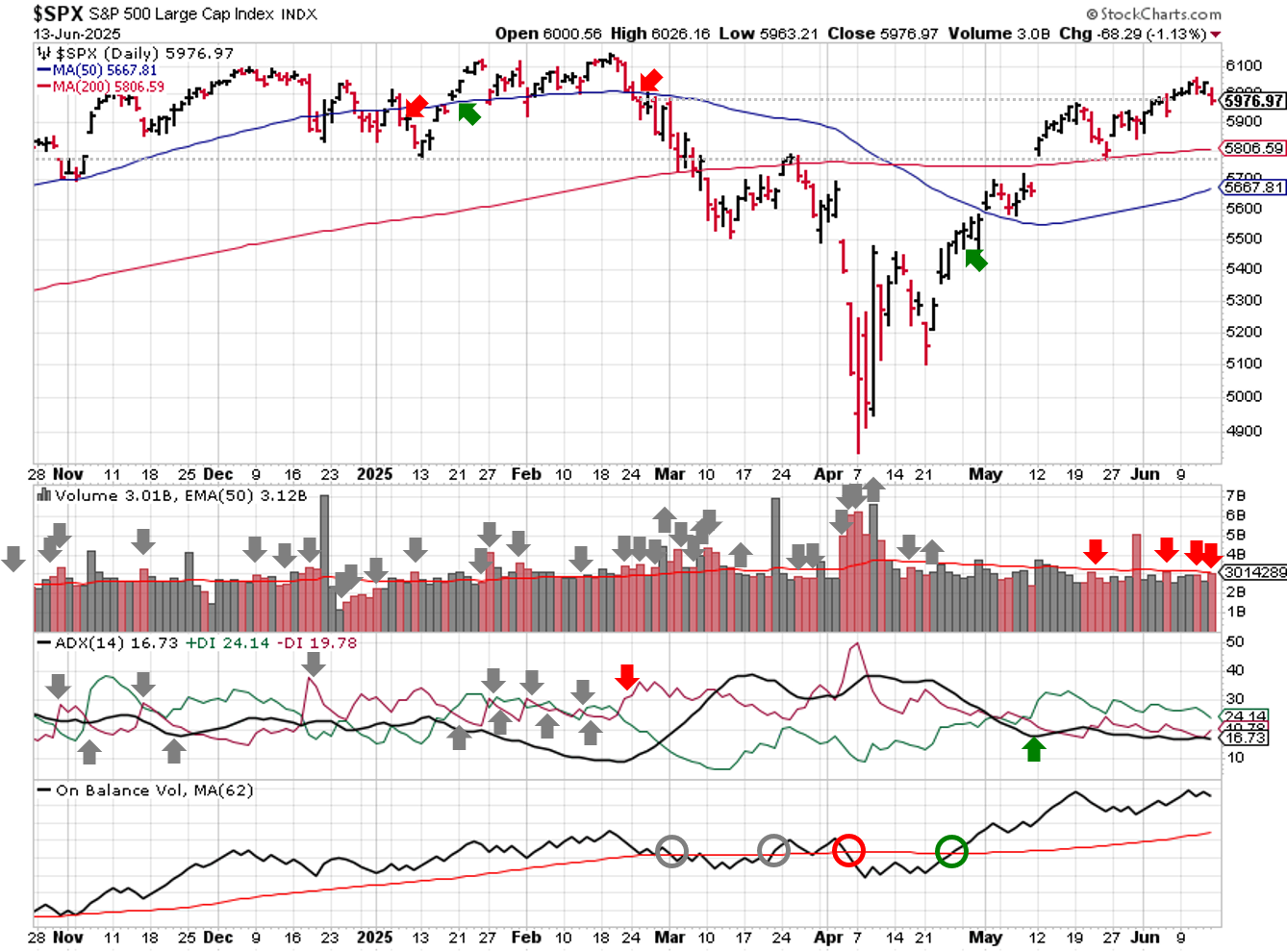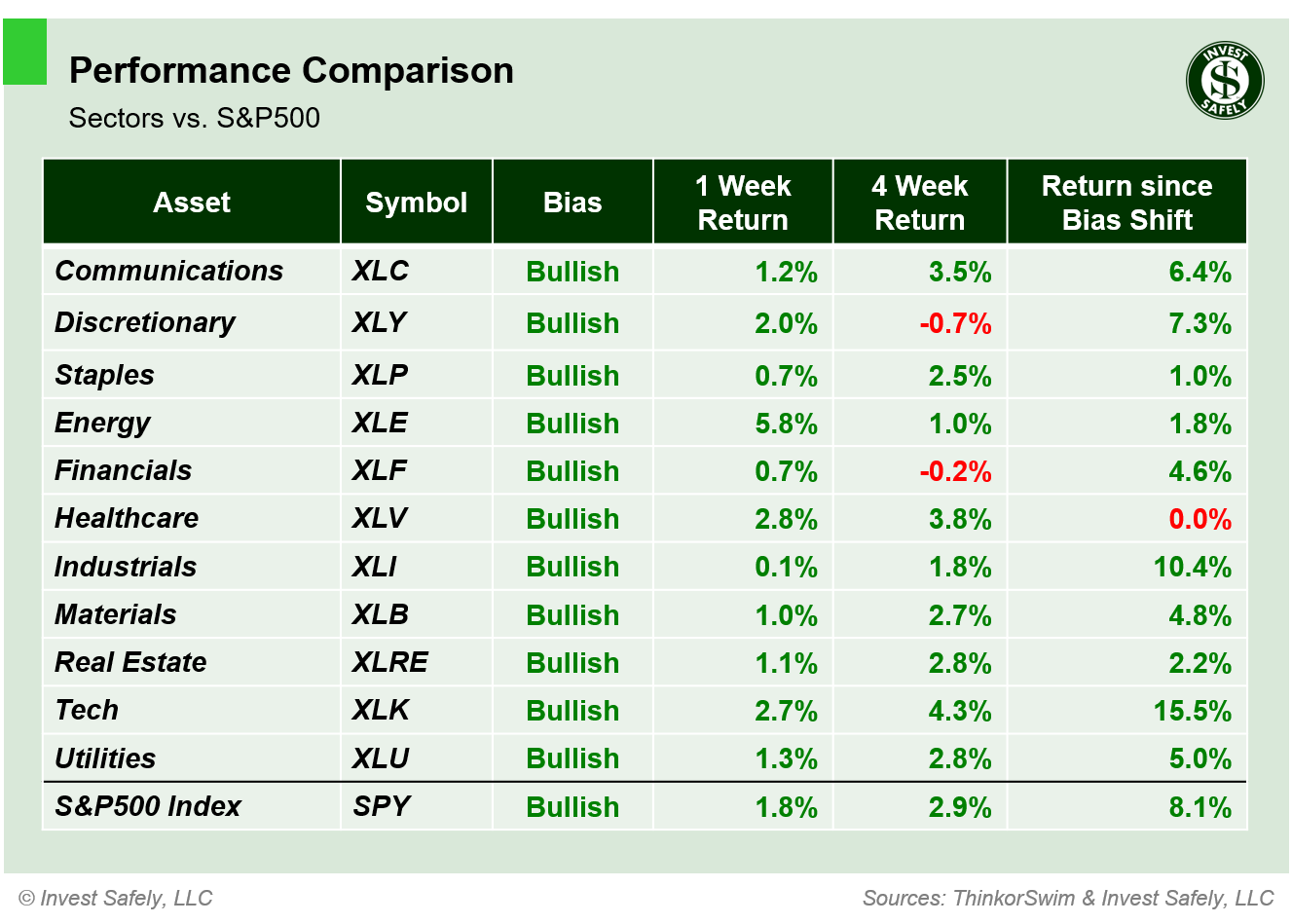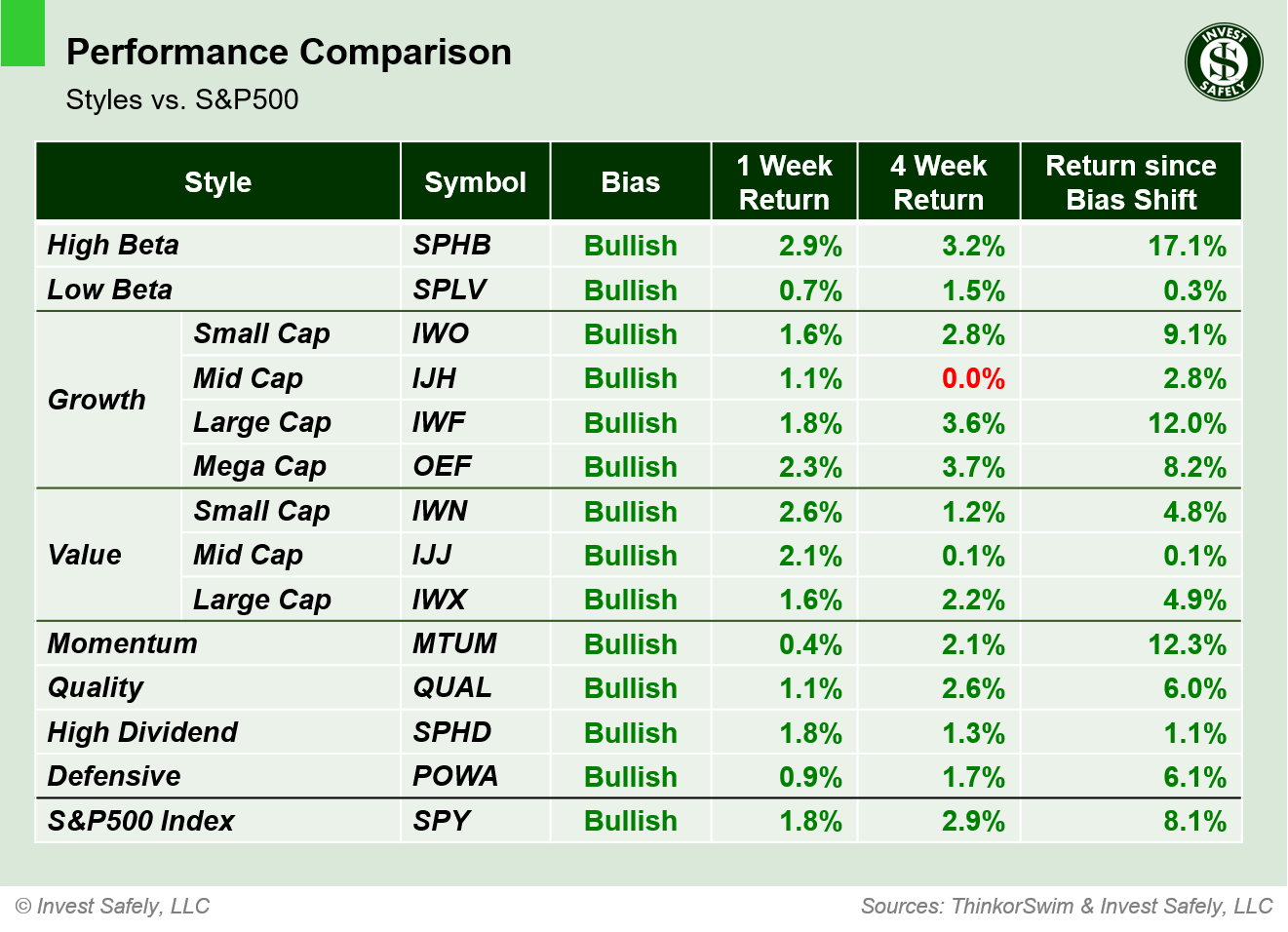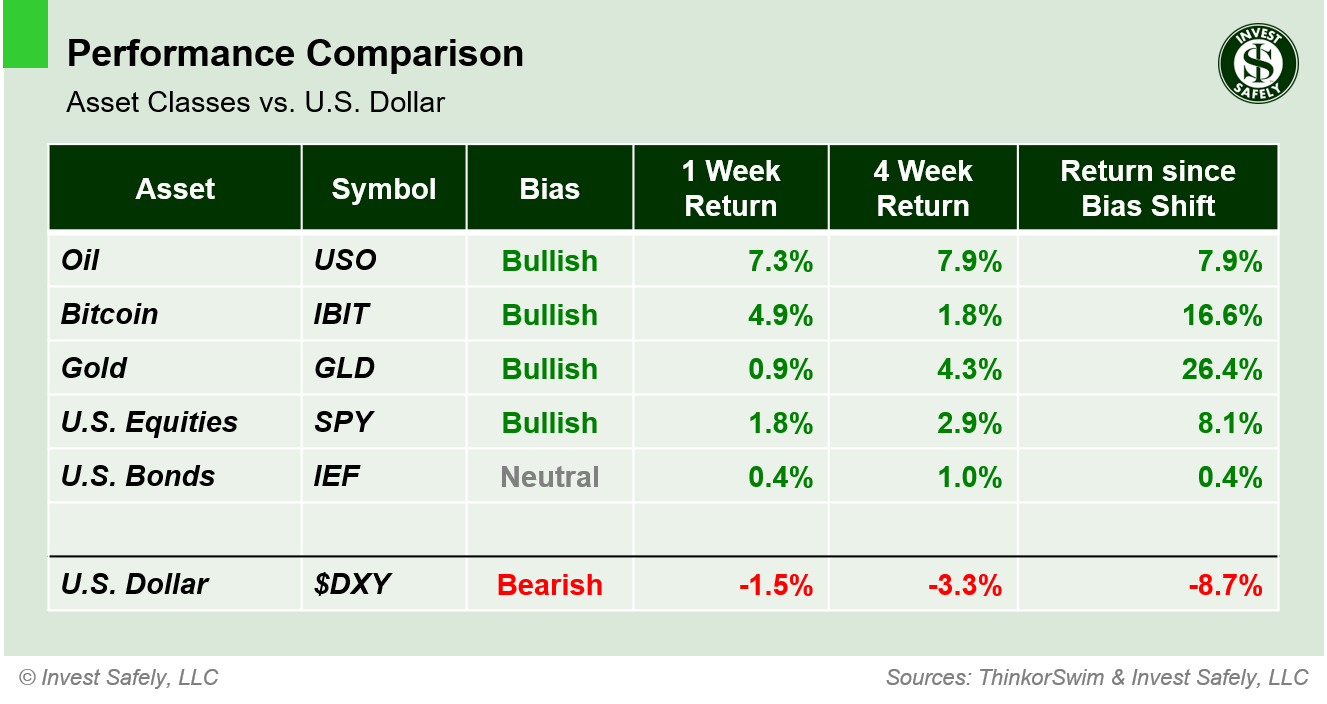Stock Market Outlook
For The Week Of June 15th = Uptrend
INDICATORS
-
ADX Directional Indicators: Uptrend
Institutional Activity (Price & Volume): Uptrend
On Balance Volume Indicator: Uptrend
ANALYSIS
The stock market outlook stays in an uptrend, despite intensifying conflict on the world stage.
The S&P500 ( $SPX ) lost 0.4% last week. The index sits ~6% above the 50-day moving average and ~3% above the 200-day moving average.
SPX Technical Analysis - June 15 2025
The ADX, Institutional Activity, and On-Balance Volume are all in bullish territory. Distribution days remain low, but are worth watching over the next week or two.
Energy ( $XLE ) led sectors higher last week, while Industrials ( $XLI ) lagged. Energy ( $XLE ) and Healthcare ( $XLV ) improved to bullish bias.
High Beta ( $SPHB ) was the best performing style for the second week in a row, and Momentum ( $MTUM ) lagged. High Dividend ( $SPHD ) improved to bullish bias.
Oil ( $USO ) led assets higher again last week, while the U.S. Dollar was the worst performer. U.S. Bonds ( $IEF ) improved to neutral again, continuing its recent oscillations between bias levels.
COMMENTARY
The uptrend in equities has remained quite resilient despite recent increases global conflict. Many market participants point out that the typical "flight to safety" trade (U.S. bonds) hasn't occurred, so financial markets are saying all is well. That's no reason to get complacent.
This time around, flows shifted more toward hard assets like gold or platinum, rather than U.S.-based assets like the dollar and bonds. Even silver has been on the move. So the flight to safety is on, just not into the traditional allocations.
The volatility index ( $VIX ) is back above 20 as well, signaling elevated risk and choppy price action ( <20 = low risk / calm, 20-30 = elevated risk / choppy, >30 = high risk / crash ).
For now, continue harvesting gains from outperforming / overbought areas and redeploy to those that are lagging / oversold, within assets showing bullish trends. But be aware that the investing environment can and does change quickly.
Inflation data rose slightly in May, though not as much as anticipated in most cases. Headline CPI rose 0.1%, while Core CPI remained steady.
| CPI (y/y) | Actual | Prior | Expected |
| Headline | +2.4% | +2.3% | +2.5% |
| Core | +2.8% | +2.8% | +2.9% |
Headline PPI rose in May, while Core PPI fell. April data was revised higher by +0.1%.
| PPI (y/y) | Actual | Prior | Expected |
| Headline | +2.6% | +2.5% | +2.6% |
| Core | +3.0% | +3.2%* | +3.1% |
This week, May retail sales data comes out Tuesday, FOMC makes another interest rate decision Wednesday, and US markets are closed Thursday for Juneteenth.
Best to Your Week!
P.S. If you find this research helpful, please tell a friend.
If you don't, tell an enemy.
Sources: Bloomberg, CNBC, Federal Reserve Bank of St. Louis, Hedgeye, U.S. Bureau of Economic Analysis, U.S. Bureau of Labor Statistics
Share this Post on:

How to Make Money in Stocks: A Winning System in Good Times and Bad.
It's one of my favorites.
I regularly share articles and other news of interest on:
Twitter (@investsafely)
Facebook (@InvestSafely)
LinkedIn (@Invest-Safely)
Instagram (@investsafely)
Invest Safely, LLC is an independent investment research and online financial media company. Use of Invest Safely, LLC and any other products available through invest-safely.com is subject to our Terms of Service and Privacy Policy. Not a recommendation to buy or sell any security.
Charts provided courtesy of stockcharts.com.
For historical Elliott Wave commentary and analysis, go to ELLIOTT WAVE lives on by Tony Caldaro. Current counts can be found at: Pretzel Logic, and 12345ABCDEWXYZ
Once a year, I review the market outlook signals as if they were a mechanical trading system, while pointing out issues and making adjustments. The goal is to give you to give you an example of how to analyze and continuously improve your own systems.
- 2015 Performance - Stock Market Outlook
- 2016 Performance - Stock Market Outlook
- 2017 Performance - Stock Market Outlook
- 2018 Performance - Stock Market Outlook
- 2019 Performance - Stock Market Outlook
- 2020 Performance - Stock Market Outlook
IMPORTANT DISCLOSURE INFORMATION
This material is for general communication and is provided for informational and/or educational purposes only. None of the content should be viewed as a suggestion that you take or refrain from taking any action nor as a recommendation for any specific investment product, strategy, or other such purpose. Certain information contained herein has been obtained from third-party sources believed to be reliable, but we cannot guarantee its accuracy or completeness.
To the extent that a reader has any questions regarding the applicability of any specific issue discussed above to his/her individual situation, he/she is encouraged to consult with the professional advisors of his/her choosing. Invest Safely, LLC is not a law firm, certified public accounting firm, or registered investment advisor and no portion of its content should be construed as legal, accounting, or investment advice.
The material is not to be construed as an offer or a recommendation to buy or sell a security nor is it to be construed as investment advice. Additionally, the material accessible through this website does not constitute a representation that the investments described herein are suitable or appropriate for any person.
Hypothetical Presentations:
Any referenced performance is “as calculated” using the referenced funds and has not been independently verified. This presentation does not discuss, directly or indirectly, the amount of the profits or losses, realized or unrealized, by any reader or contributor, from any specific funds or securities.
The author and/or any reader may have experienced materially different performance based upon various factors during the corresponding time periods. To the extent that any portion of the content reflects hypothetical results that were achieved by means of the retroactive application of a back-tested model, such results have inherent limitations, including:
Model results do not reflect the results of actual trading using assets, but were achieved by means of the retroactive application of the referenced models, certain aspects of which may have been designed with the benefit of hindsight
Back-tested performance may not reflect the impact that any material market or economic factors might have had on the use of a trading model if the model had been used during the period to actually manage assets
Actual investment results during the corresponding time periods may have been materially different from those portrayed in the model
Past performance may not be indicative of future results. Therefore, no one should assume that future performance will be profitable, or equal to any corresponding historical index.
The S&P 500 Composite Total Return Index (the "S&P") is a market capitalization-weighted index of 500 widely held stocks often used as a proxy for the stock market. Standard & Poor's chooses the member companies for the S&P based on market size, liquidity, and industry group representation. Included are the common stocks of industrial, financial, utility, and transportation companies. The S&P is not an index into which an investor can directly invest. The historical S&P performance results (and those of all other indices) are provided exclusively for comparison purposes only, so as to provide general comparative information to assist an individual in determining whether the performance of a specific portfolio or model meets, or continues to meet investment objective(s). The model and indices performance results do not reflect the impact of taxes.
Investing involves risk (even the “safe” kind)! Past performance does not guarantee or indicate future results. Different types of investments involve varying degrees of underlying risk. Therefore, do not assume that future performance of any specific investment or investment strategy be suitable for your portfolio or individual situation, will be profitable, equal any historical performance level(s), or prove successful (including the investments and/or investment strategies describe on this site).






